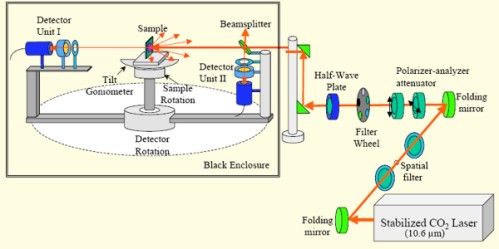| * |
|
Infrared laser gonioreflectometer instrument (ILGRI)
Description:The Infrared Laser Gonioreflectometer Instrument (ILGRI) is used to measure the bidirectional reflectance distribution function (BRDF) or the bidirectional transmittance distribution function (BTDF) of flat and structured samples, such as V-grooved surfaces or cavities, in the infrared spectral range. The ILGRI enables the measurement in absolute units (1/sr) of the BRDF and BTDF as functions of 7 variables (2 angular coordinates for incident direction, 2 for the detector angular position, wavelength, and incident as well as scattered polarization).
The BRDF and BTDF can thus be taken as a fundamental quantities for the optical characterization of an object and they are correspondingly important in a large variety of applications. BRDF and BTDF are critical to computer image analysis and reconstruction, for applications in targeting, reconnaissance and surveillance, virtual reality systems and simulators, radiative heat transfer, computer graphics, optical testing, telemedicine, robotics, etc.
Specifications / Capabilities:The complete instrument consists of three main parts: the infrared source section, the sample manipulation section, and the detection section. The ILGRI layout showing the main components is depicted below.
System features: The infrared source section consists of lasers (a line-tunable, stable CO2, near infrared diode, and continuously tunable OPO PPLN lasers) and a suite of optics including mirrors and lenses for beam direction and adjustment, polarizers and retarders for beam polarization control, and polarizers and filters for beam power level adjustment from 1 nW to 1 W. The addition of other laser wavelengths in the infrared is currently underway. The sample manipulation section consists of computer controlled motorized rotation, goniometer and translation stages for alignment, and setting the polar and azimuthal angles of incidence with respect to the sample surface. The detector section consists of pyroelectric and MCT detectors, along with an aperture, a lens and polarizers. Two setups are used: one with a beamsplitter and mirror that enable measurements at and close to the retroreflection directions, where the reflected light is folded to the detector and its associated optics (aperture, lens and polarizer), and a second with a direct path to the detector and its optics. The ILGRI also contains several quadrant detectors, which enable alignment of the stages, axes of rotation, sample surface, and input laser beam, all to within 50 µm of each other. Associated Programs/Projects: |
 Contact
Name: Leonard Hanssen |

 The BRDF (BTDF) is a measure of the amount of light reflected (transmitted) by a surface from one direction into another. Integrating it over specified incident and reflected (transmitted) solid angles defines the reflectance (transmittance), which also can be easily related to the absorptance (or emittance) of a sample.
The BRDF (BTDF) is a measure of the amount of light reflected (transmitted) by a surface from one direction into another. Integrating it over specified incident and reflected (transmitted) solid angles defines the reflectance (transmittance), which also can be easily related to the absorptance (or emittance) of a sample.